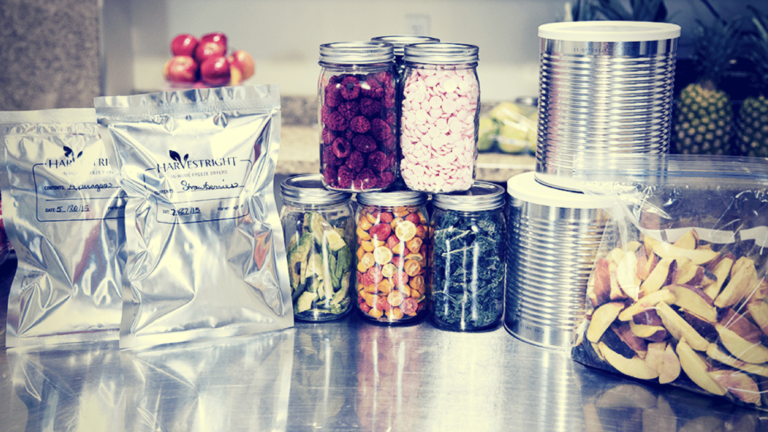Lyophilization is the process by which freeze-dried food can be produced from conventional food. Its principle is to remove the water contained in a food that has been previously frozen, in order to greatly limit its oxidation (basically, the stuff that makes food decay) and thus to considerably increase the time that it can be preserved. This process is not only used for food but is also used for some medicines.
Historically, some sources claim that Andean Indians already used a similar process, lyophilizing potatoes. They used mountain ice to cool them, before allowing them to dry in the sun at high altitudes. In Europe, freeze-dried food appeared in 1906, when the process was invented by a Frenchman (Cocorico!): Arsene d’Arsonval, who was a physicist at the Collège de France.
Is this bad for health?
Not at all ! The majority of foods retain all their qualities and beneficial properties when freeze-dried (in any case, those which are commonly freeze-dried). Moreover, you often eat freeze-dried foods if you buy, for example, soluble coffee, soup or milk powder, or Chinese noodles (we recommend you buy these last two products that are not too expensive And can be very useful in case of shortage!).
Some manufacturers sell, for example, lyophilized vegetables for canteens (CHU, lycées, etc.) and once reconstituted, they are difficult to differentiate from supermarket vegetables I’m not talking about our vegetable garden, Obviously …) And I want to take advantage of it here to talk about the difference between freeze-dried food and dehydrated food.
Be careful not to be confused! While dehydrated food will be easier to make, and therefore cheaper, it does not have the same benefits as lyophilized food at all. Unlike the latter, dehydrated food will have lost much of its taste, nutritional qualities, and appearance. In addition, it will keep for shorter periods (less than one year for dehydrated food, compared to 2 to 5 years for lyophilized food!) It does not have the same benefits as lyophilized food.
Summary
In summarizing, here is a list of the advantages and disadvantages of freeze-dried food:
Conservation (very) long: up to 5 years
Preservation of taste, structure, color, consistency, etc.
Maintaining the main nutritional qualities
Lighter Weight
Less volume occupied for storage
Rehydration is rapid
Costly method that makes lyophilized foods expensive
Must be kept under vacuum (careful not to break the vacuum)
Impossible to do at home
How and why do you get lyophilized food?
There are brands and specialty stores, but these stores are not very frequent. The easiest way is to buy online. So, you can for example buy a pack of 60 meals on Amazon . You can also buy dishes by unit . Attention, unlike the process of dehydration which is fairly easy to make and therefore inexpensive , the freeze-drying process (which we will explain later in this article) is expensive and lyophilized products will therefore be systematically expensive.
Also, I do not think freeze-dried foods should be used as reserves at home. For this, it is much simpler to buy (or better, to do) preserves, Non-perishable foodstuffs and possibly dehydrated food, which keeps less for a long time but costs much less. Freeze-dried food is of real interest only if you have to take only one bag with you, in which case it can remain in your evacuation bag for several years, will not weigh heavily, and so on.
The lyophilization process
The lyophilization process is based on two principles: cold, and vacuum. It is done in 3 steps:
- Freezing: rapid descent to -80 ° C. The water is then evidently in the solid state (ice)
- Primary desiccation: By lowering the pressure (“vacuum”) the ice is “sublimated”, ie it passes directly from the solid to the gaseous state. The resultant water vapor can then be readily removed
- Secondary dessication: extracts water residues by “desorption” (complex process which is in fact the inverse of absorption: the solid separates from the water molecules), with an even lower pressure.
Once these three steps have been carried out, the product must be kept under vacuum. There then remains only 1% to 5% of the water initially contained in the product: it is lyophilized. It is understandable from reading the process why freeze-dried food is expensive, and therefore why it is better to use it only in the event of evacuation.
I think it’s really good to have a week or two (60 meals, for example, to keep 15 days to 2, that’s what I have at home), but Domestic reserves, canned foods are much more suitable. In short: freeze-dried food can be useful, but it should be used intelligently and not over-used.
We will soon be writing an article on canned foods, how to build a stock adapted to your situation, and how to make yourself effective preserves. We are looking for someone who would have great experience in canning and could help us with this article!
Feel free to share our site around you and especially on facebook and social networks and to subscribe to our Newsletter for more information 😉Thank you for your help!
